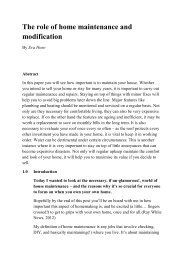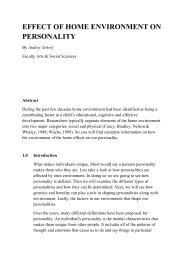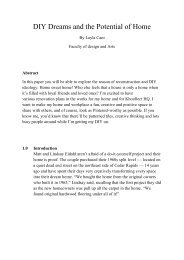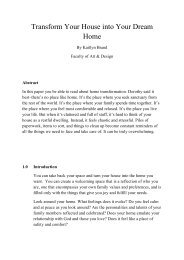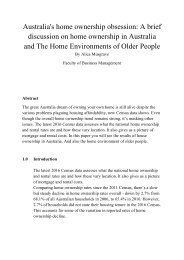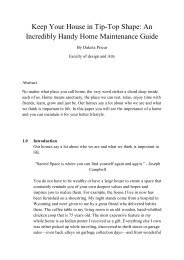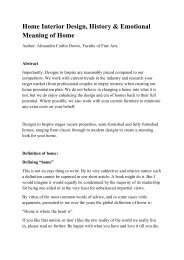Home Interior and new Fang Shui trend
You also want an ePaper? Increase the reach of your titles
YUMPU automatically turns print PDFs into web optimized ePapers that Google loves.
<strong>Home</strong> <strong>Interior</strong> <strong>and</strong> <strong>new</strong> Feng <strong>Shui</strong> <strong>trend</strong><br />
By Gabriel Fuller<br />
Faculty Arts & Design<br />
Abstract<br />
<strong>Interior</strong> design is a multi-faceted profession in which creative <strong>and</strong> technical<br />
solutions are applied within a structure to achieve a built interior environment.<br />
These solutions are functional, enhance the quality of life <strong>and</strong> culture of the<br />
occupants, <strong>and</strong> are aesthetically attractive. In this paper you will see the fang<br />
shuai‘s <strong>new</strong> <strong>trend</strong> <strong>and</strong> how interior will bring the positivity to your home <strong>and</strong><br />
attitude.<br />
1.0 Introduction<br />
Designs are created in response to <strong>and</strong> coordinated with the building<br />
shell, <strong>and</strong> acknowledge the physical location <strong>and</strong> social context of the<br />
project. Designs must adhere to code <strong>and</strong> regulatory requirements, <strong>and</strong><br />
encourage the principles of environmental sustainability.<br />
Figure 1
The interior design process follows a systematic <strong>and</strong> coordinated<br />
methodology, including research, analysis <strong>and</strong> integration of knowledge<br />
into the creative process, whereby the needs <strong>and</strong> resources of the client<br />
are satisfied to produce an interior space that fulfils the project goals.<br />
<strong>Interior</strong> design includes a scope of services performed by a professional<br />
design practitioner, qualified by means of education, experience, <strong>and</strong><br />
examination, to protect <strong>and</strong> enhance the life, health, safety <strong>and</strong> welfare of<br />
the public. These services may include any or all of the following tasks:<br />
‣ Research <strong>and</strong> analysis of the client's goals <strong>and</strong> requirements; <strong>and</strong><br />
development of documents, drawings <strong>and</strong> diagrams that outline those<br />
needs;<br />
‣ Formulation of preliminary space plans <strong>and</strong> two <strong>and</strong> three dimensional<br />
design concept studies <strong>and</strong> sketches that integrate the client's program<br />
needs <strong>and</strong> are based on knowledge of the principles of interior design<br />
<strong>and</strong> theories of human behavior;<br />
‣ Confirmation that preliminary space plans <strong>and</strong> design concepts are<br />
safe, functional, aesthetically appropriate, <strong>and</strong> meet all public health,<br />
safety <strong>and</strong> welfare requirements, including code, accessibility,<br />
environmental, <strong>and</strong> sustainability guidelines;<br />
‣ Selection of colors, materials <strong>and</strong> finishes to appropriately convey the<br />
design concept, <strong>and</strong> to meet socio-psychological, functional,<br />
maintenance, life-cycle performance, environmental, <strong>and</strong> safety<br />
requirements;<br />
‣ Selection <strong>and</strong> specification of furniture, fixtures, equipment <strong>and</strong><br />
millwork, including layout drawings <strong>and</strong> detailed product description;<br />
<strong>and</strong> provision of contract documentation to facilitate pricing,<br />
procurement <strong>and</strong> installation of furniture;<br />
‣ Provision of project management services, including preparation of<br />
project budgets <strong>and</strong> schedules;
‣ Preparation of construction documents, consisting of plans, elevations,<br />
details <strong>and</strong> specifications, to illustrate non-structural <strong>and</strong>/or nonseismic<br />
partition layouts; power <strong>and</strong> communications locations;<br />
reflected ceiling plans <strong>and</strong> lighting designs; materials <strong>and</strong> finishes; <strong>and</strong><br />
furniture layouts;<br />
‣ Preparation of construction documents to adhere to regional building<br />
<strong>and</strong> fire codes, municipal codes, <strong>and</strong> any other jurisdictional statutes,<br />
regulations <strong>and</strong> guidelines applicable to the interior space;<br />
‣ Coordination <strong>and</strong> collaboration with other allied design professionals<br />
who may be retained to provide consulting services, including but not<br />
limited to architects; structural, mechanical <strong>and</strong> electrical engineers,<br />
<strong>and</strong> various specialty consultants;<br />
‣ Confirmation that construction documents for non-structural <strong>and</strong>/or<br />
non-seismic construction are signed <strong>and</strong> sealed by the responsible<br />
interior designer, as applicable to jurisdictional requirements for filing<br />
with code enforcement officials;<br />
‣ Administration of contract documents, bids <strong>and</strong> negotiations as the<br />
client's agent;<br />
Observation <strong>and</strong> reporting on the implementation of projects while in<br />
progress <strong>and</strong> upon completion, as a representative of <strong>and</strong> on behalf of<br />
the client; <strong>and</strong> conducting post-occupancy evaluation reports.(csbsuni,<br />
2015)<br />
2.0 Literature Review<br />
2.1 Importance of <strong>Interior</strong> Design<br />
<strong>Interior</strong> design is not just about the looks of the building‘s interior.<br />
Well, it is but it also plays the key role in its functionality because<br />
even the largest house can lack space if having a poor interior<br />
design, while a tiny apartment can be transformed into a cosy<br />
residence with enough space for just about everything with the<br />
right design <strong>and</strong> the use of a contemporary staircase. Yes, interior<br />
design is much more important than it may seem at a first glance<br />
<strong>and</strong> can be easily compared with the importance of architecture, at
least when it comes to interior. Hiring an interior designer is<br />
therefore more than just a good idea if building a <strong>new</strong> house or<br />
remodelling/renovating the existing one.<br />
Figure 2<br />
The house‘s interior must be aesthetically appealing <strong>and</strong> practical<br />
at the same time. However, what is aesthetically appealing such as<br />
a beautiful Blinds or great looking modern boiler stoves depends<br />
greatly on whom you ask because everyone has different needs <strong>and</strong><br />
lifestyle. As a result, the st<strong>and</strong>ard architectural plans rarely meet<br />
the client‘s needs completely. With an aim to save money for an<br />
interior designer <strong>and</strong> modifications of the architect‘s plan, many<br />
people make the crucial mistake by accepting the offered plan even<br />
if they would prefer for the toilet to be separated from your<br />
bathroom or perhaps create a smaller living room to gain enough<br />
space for a home office for example. And when they realize that<br />
they are serving the house instead of vice versa, they spend even<br />
more money for alterations than they would if hiring an interior<br />
designer when starting the project. It is often difficult to decide<br />
which interior design meets your needs <strong>and</strong> lifestyle the most<br />
because most designs usually do not show the need for<br />
improvements or alterations until you are actually using them.<br />
However, an interior designer will help you avoid finding yourself
with a <strong>new</strong>ly built or renovated house that could have been done<br />
better because all interior designers are trained to help their clients<br />
choose a design according to their lifestyle.<br />
Figure 3<br />
But they do not only take care of the layout but they also help you<br />
choose the right decor, lightning, paint colour, etc. depending on<br />
what you want to leave over to an expert <strong>and</strong> how much you can<br />
afford to spend on the project.<br />
Unfortunately, the best interior designers are not inexpensive but it<br />
is far more expensive to tear down the walls or build <strong>new</strong> ones a<br />
year or two after completion of the project. However, if you know<br />
exactly what you need, you can design your home‘s interior by<br />
yourself <strong>and</strong> ask an architect to make it realisable. Another great<br />
idea which will help you reduce the costs for an interior designer as<br />
well as to avoid finding yourself unsatisfied with the results of your<br />
project is to hire an interior designer only for the key works such as<br />
layout <strong>and</strong> take care of the easier part of interior design yourself.<br />
Think about it but take plenty of time before you make your final<br />
decision because the interior of your home should not only look<br />
good but also needs to be functional.(transedit, 2016)<br />
2.2 What is Feng Shuai<br />
Feng shui is an ancient art <strong>and</strong> science that was formalized over<br />
3,000 years ago in China. In literal translation feng means<br />
"wind" <strong>and</strong> shui means "water." In Chinese culture, wind <strong>and</strong> water
are associated with good health, thus good feng shui came to mean<br />
good fortune. Conversely, bad feng shui means bad luck or<br />
misfortune.<br />
Some elements of Feng shui practice date back at least 6,000 years,<br />
<strong>and</strong> it contains elements of various branches of scholarly study,<br />
including physics, philosophy, astronomy, <strong>and</strong> astrology. It is<br />
related closely to closely to the Taoist vision <strong>and</strong> underst<strong>and</strong>ing of nature,<br />
particularly the idea that the l<strong>and</strong> is alive <strong>and</strong> filled with Chi, or<br />
energy. Other concepts shared between feng shui <strong>and</strong> Taoism<br />
include the polarities of yin <strong>and</strong> yang—the polar opposites that<br />
cannot exist without the other—<strong>and</strong> the theory of five elements.<br />
Feng shui is sometimes thought to be the art of placement—<br />
underst<strong>and</strong>ing how the placement of yourself <strong>and</strong> objects within a<br />
space affects your life in various areas of experience. It is a<br />
complex body of knowledge that teaches us how to balance <strong>and</strong><br />
harmonize with the energies in any given space—be it a home,<br />
office, or garden. Its aim is to assure good fortune for the people<br />
inhabiting a space. Although regarded by some in the scientific<br />
community as a pseudo-science, feng shui has had an impact on the<br />
aesthetics of interior design <strong>and</strong> the architectural layout of living<br />
<strong>and</strong> working spaces, both in its native eastern <strong>and</strong>, more recently,<br />
western cultures.<br />
Since good fortune comes in many forms, including better health, a<br />
successful career, or a fulfilling love life, feng shui practice<br />
includes detailed tips for almost every area of your life. The main<br />
tools used in analyzing the feng shui of any space are the feng<br />
shui compass <strong>and</strong> the bagua.<br />
2.3 Two Basic Feng <strong>Shui</strong> Principles<br />
The principle of yin <strong>and</strong> yang1: The Taoist theory of yin <strong>and</strong> yang is<br />
essential to feng shui. At the core of this principle lies a belief that<br />
a balance of the feminine (Yin) <strong>and</strong> the masculine (Yang) in our<br />
lives is necessary to maintain a good flow of Chi <strong>and</strong> a content,<br />
happy, successful life.
In Taoist <strong>and</strong> Feng shui theory, yin <strong>and</strong> yang are opposites that are<br />
dependent upon one another <strong>and</strong> which must always be in balance.<br />
The principle of duality—the idea that all things are balanced<br />
blends of two things—is at the root of yin/yang theory. While most<br />
other spiritual philosophies believe in opposing dualities, such as<br />
good vs. evil, the Chinese Taoist system believes that balance <strong>and</strong><br />
equilibrium between opposites is the desirable state. Discord<br />
occurs when one principle outweighs the other.<br />
Figure 4<br />
The principle of five elements2: Also central to Taoism <strong>and</strong> feng<br />
shui is the theory of five elements. By tradition, feng shui practice<br />
holds that all things consist of varying degrees of five elements. In<br />
the feng shui system, wood, fire, earth, metal, <strong>and</strong> water are the<br />
five elements, <strong>and</strong> each is represented by certain colors that can<br />
help us bring harmony to a particular space.<br />
The five elements can interact in any number of ways, some<br />
constructive <strong>and</strong> some destructive. In the constructive cycle, for<br />
example, water provides moisture for trees (wood) to grow; wood<br />
then becomes a fuel for fire; the residue of fire is ash or soil; the<br />
ash/soil is the essence of earth minerals that form metals; <strong>and</strong> as<br />
metal cool, they allow water to condense, completing the cycle. In
a destructive cycle, on the other h<strong>and</strong>, metal can cut wood; <strong>and</strong><br />
wood can grow over <strong>and</strong> consume soil. (RODIKA TCHI, 2018)<br />
3.0 How Does Feng Shuai Work?<br />
Feng shui‘s architectural principles are cryptically based on the invisible<br />
force of qi, which can be directly translated as ―air,‖ but it is more<br />
analogous to the universal principles of physics. Qi is the same<br />
energy Shaolin monks use to break bricks with their bare h<strong>and</strong>s (here, the movement<br />
of qi is a phenomenon proven by medical science), <strong>and</strong> which Chinese<br />
medicine rejuvenates in the body. The concept of qi comes from Daoism,<br />
whose central tenet is that energy, or essence, is impermanent in form,<br />
<strong>and</strong> fluid in nature ( 道 可 道 非 常 道 —The Dao that can be put into words<br />
is not the eternal Dao). According to Daoism, water is the ideal state of<br />
matter because it flows effortlessly from place to place, knowing<br />
instinctively the ―way‖ or the 道 by finding the path of least resistance.<br />
While describing architecture in metaphorical terms seems like a lot of<br />
superstitious gobbledygook, feng shui can be understood as the attempt to<br />
give living spaces a feeling of effortlessness <strong>and</strong> comfort. For example, in<br />
suggesting that a dragon should travel through the chambers of a building<br />
before it was constructed, feng shui is suggesting that we look for any<br />
awkward turns or cramped spaces in our building designs, the same way<br />
that buildings today have to be wheelchair accessible.<br />
In deciding the exact position of a building <strong>and</strong> the way it should be<br />
constructed, feng shui involved a lot of complex calculations <strong>and</strong><br />
meticulous attention to detail. The luopan ( 罗 盘 luópán), or magnetic<br />
compass, was invented for feng shui purposes <strong>and</strong> used as a tool for l<strong>and</strong>based<br />
divination before it was ever taken to sea. Luo means everything,<br />
<strong>and</strong> pan means bowl, making the magnetic compass metaphorically a<br />
bowl that contains all the mysteries of the universe. One of its functions<br />
was to measure various l<strong>and</strong>scape elements, as rivers, hills, or other<br />
geographical features were deemed to have some influence on the qi<br />
running through the area. Thous<strong>and</strong>s of years before the scientific<br />
discovery of magnetic polarity, the ancient Chinese described these forces<br />
in terms of yin (feminine receiving force) <strong>and</strong> yang (masculine pushing<br />
force). The balance of these universal forces was essential to finding the<br />
right place for a structure with good qi, in the same waythat Chinese
medicine attempts to restore the balance of yin <strong>and</strong> yang to the body.<br />
Each of eight directions had their own special characteristics of qi, which<br />
made it important to choose the right orientation for a structure. In<br />
addition, the luopan allowed more precise geographical <strong>and</strong> climate<br />
considerations to be taken into account. Ideal buildings were high <strong>and</strong><br />
solid towards the north to break the wind, <strong>and</strong> low <strong>and</strong> open towards the<br />
south to capture light, warmth, <strong>and</strong> the summer breeze.<br />
Before the invention of the compass, the Form School used geographical<br />
features to make feng shui judgments, <strong>and</strong> was more intuitively based on<br />
harmony with natural surroundings. For example, the Form School holds<br />
that cities should be built against a mountain range at their north end to<br />
block the flow of bad qi. Later, the Compass School developed<br />
mechanical techniques to identify the distinct types of qi that come from<br />
each of the eight directions, involving complex calculations using<br />
instruments such as the luopan.<br />
Figure 5<br />
Complex metaphysical calculations also took into account the five<br />
elements—metal, earth, fire, water, <strong>and</strong> wood—which also feature<br />
prominently in other disciples stemming from Chinese philosophy<br />
like martial arts, medicine, <strong>and</strong> choosing auspicious names. The five elements, like<br />
qi, are invisible forces which destroy <strong>and</strong> create when interacting with<br />
one another. According to Chinese philosophy, earth is a buffer zone in<br />
which life can exist because extreme elements <strong>and</strong> polarities cancel each
other out. It is the feng shui architect‘s job to balance these five elements<br />
against one another, although a great deal of flexibility is allowed when it<br />
comes to the design features that elements are incorporated into. The<br />
order of architectural application of these elements comes in decreasing<br />
order of form, orientation, placement, color, material, texture, <strong>and</strong><br />
numbers. If there are urban or topographical constraints on the design of<br />
the building, then the balance of the elements cannot be achieved in form,<br />
for example, then the architect can compensate with colors that would<br />
offset the imbalance.(Patrick Kim, 2016)<br />
4.0 Feng <strong>Shui</strong> Tips To Clean Your <strong>Home</strong> & Your Life<br />
In spring, the earth leaps into action. Spring is the season of blooming<br />
<strong>and</strong> sprouting, <strong>and</strong> the best way to prepare for its arrival is to clear lots of<br />
space for the greatness of all that's about to emerge in your life. It's time<br />
to come out of hibernation <strong>and</strong> stretch into the sunshine. Flowers wake<br />
up. Seeds are planted. The days stay lighter longer.<br />
In the ancient practices of feng shui <strong>and</strong> Traditional Chinese Medicine<br />
there's a reverence for staying connected to nature <strong>and</strong> flowing with the<br />
seasons. While you do some cleaning, you may want to think of ways to<br />
spend more time outside in the months to come to really harness the<br />
greatness of the seasonal switch.(BondCleaninginPerth, 2016)<br />
Today I wanted to share a few feng shui-ed cleaning tips that can help<br />
you create the foundation for a season of real abundance:<br />
1. Declutter!<br />
I often recommend clearing out the clutter in your home, office, car <strong>and</strong><br />
any other space in your life, but in spring, focus your efforts on what you<br />
need to clear away in order to feel more active. Bring your workout gear<br />
front <strong>and</strong> center in your closet, along with brighter colors if you really<br />
want to embrace the rebirth of the season. Deep cleaning the whole<br />
kitchen — particularly the refrigerator — will somewhat strangely make<br />
you feel incredible. It's a great prosperity feng shui tip, too!<br />
2. Clean under things.<br />
Dust collects under things. That dust creates stagnation. Stagnation is the<br />
opposite of flow <strong>and</strong> circulation. Flow <strong>and</strong> circulation bring health <strong>and</strong>
prosperity. Cleaning under things thoroughly — your sofa, your bed …<br />
even the oven <strong>and</strong> refrigerator if possible — will open up any stagnant<br />
energy <strong>and</strong> get the flow going. This action will help you to open up stuck<br />
areas of your own life as well, so embrace it!<br />
3. Wash your windows.<br />
Another area of cleaning neglect for many, washing the windows gives<br />
you a fresh perspective on life. While you're at it, pop out your blinds if<br />
you have them <strong>and</strong> wash them in your tub; toss your curtains in the<br />
laundry or dry-clean them. You'll be astonished by the difference this<br />
makes in your home, particularly if you open your windows often.<br />
4. Welcome in <strong>new</strong> ideas.<br />
Look through your bookshelves <strong>and</strong> see if you can donate or gift some to<br />
friends who might love them. Now you have room for fresh ideas to come<br />
into your life this season. Pick up a few fresh books that feel light,<br />
engaging <strong>and</strong>, of course, compelling.<br />
5. Practice cash shui!<br />
Polish the flow of your finances. Spring is a season of action, <strong>and</strong> you<br />
want to be sure that action doesn‘t come at the expense of your<br />
prosperity. Beyond rooting through your files <strong>and</strong> getting your taxes<br />
prepared, think about a few <strong>new</strong> ways to organize, invest or save money.<br />
A budget, a visit to your money manager, some accounting software or<br />
simply deciding to live using only cash to buy things (a very effective<br />
strategy for people who impulse buy with credit cards) can make this a<br />
wealthier spring.(Dana Claudat, 2013)<br />
5.0 <strong>Interior</strong> Design <strong>and</strong> Feng <strong>Shui</strong><br />
FENG <strong>Shui</strong> can be a complex practice <strong>and</strong> if you are uninformed it can<br />
leave you more stressed <strong>and</strong> confused than relaxed about how to create a<br />
peaceful <strong>and</strong> harmonious environment.<br />
There are many things to bear in mind when applying the Feng <strong>Shui</strong><br />
principals to your home, office or life. The main goals are flow <strong>and</strong><br />
energy within the house i.e. positive <strong>and</strong> negative, wealth, health,<br />
relationships, colour, shapes <strong>and</strong> objects.
Figure 6<br />
Then there are the elements such as wind, fire, earth <strong>and</strong> water. If you<br />
have an interest in Feng <strong>Shui</strong> but you‘re not sure where to start, have a<br />
look at the essence <strong>and</strong> the overall ideals of this practice.<br />
The basic principals of Feng <strong>Shui</strong> are about creating an environment that<br />
enriches, nourishes <strong>and</strong> enhances your life, which is also the direct aim of<br />
<strong>Interior</strong> Designers.<br />
You don‘t have to completely redesign your home to introduce these<br />
elements. Just a few simple changes can be enough to create an instant<br />
change.<br />
6.0 Where to start?<br />
6.1 Clutter - Clutter is an instant negative.<br />
If your space is cluttered it is not only visually cluttered but can<br />
cause ‗emotional‘ clutter.<br />
This can create wasted energy on worrying about a situation that<br />
can eventuate exhaustion <strong>and</strong> a feeling of being constantly drained.<br />
Give yourself small projects to start with (so you don‘t feel<br />
overwhelmed) <strong>and</strong> build on this each week.<br />
6.2 Colour – Match the colour to the situation.
There is enough on the psychology of colour to fill a library but<br />
how to choose your colour can be as simple as the mood you are<br />
trying to reflect.<br />
‣ Red – incites passion, power <strong>and</strong> motivation<br />
‣ Green – reflects harmony, nature, growth <strong>and</strong> prosperity<br />
‣ Blue – is known for imagination, the ocean, serenity <strong>and</strong><br />
calm<br />
‣ White - reflects purity, innocence <strong>and</strong> freshness<br />
6.3 Energy <strong>and</strong> Flow – This is as simple as the ‗blocks‘ put in front of<br />
you. Bold feature walls or contrasting couches, such as a black<br />
leather couch on top of off-white carpet might be vibrant <strong>and</strong><br />
energising in a large open plan room or warehouse setting but<br />
move that into a small, single room <strong>and</strong> it becomes confronting <strong>and</strong><br />
blocks your energy <strong>and</strong> thoughts.<br />
You can eliminate blocks by placing a darker rug under the couch<br />
so there isn‘t such a severe contrast to the carpet. Or change the red<br />
wall to a more restful white like the carpet to maintain a feeling of<br />
softness <strong>and</strong> give an illusion of flowing space.<br />
6.4 Light – Introducing natural light into your environment adds to the<br />
quality of the mood within your home <strong>and</strong> cuts the cost of your<br />
energy bills.<br />
Opening your home with vast windows <strong>and</strong> inviting the outdoors in<br />
creates calm <strong>and</strong> harmony with nature <strong>and</strong> your environment.<br />
To get a true reading of your home <strong>and</strong> how Feng <strong>Shui</strong> can<br />
enhance your life get an individual reading from a professional<br />
Feng <strong>Shui</strong> master.<br />
Everybody‘s house is different so this will give a true indication of<br />
what your needs will be.<br />
<strong>Interior</strong> designer Shaynna Blaze from the LifeStyle Channel‘s<br />
Selling Houses Australia is an expert on home makeovers <strong>and</strong> can<br />
answer all your questions on interior decorating <strong>and</strong> design ideas<br />
at www.lifestyle.com.au/shaynna.(Shaynna Blaze, 2017)
7.0 Feng <strong>Shui</strong> in <strong>Interior</strong> Design<br />
Feng shui is the art of organizing spaces to increase positive energy or<br />
Chi in our environment. Feng shui pronounced "fung shway" originated<br />
in China. Feng shui means wind <strong>and</strong> water in Chinese.<br />
Figure 7<br />
To create a healthy, wealthy, <strong>and</strong> balanced interior design<br />
environment you should use the five feng shui elements of nature (water,<br />
fire, earth, wood <strong>and</strong> metal) in different combinations <strong>and</strong> form in every<br />
room of your living space. Here are my best feng shui tips to help you<br />
create balance, flow <strong>and</strong> harmony in your living space:<br />
Figure 8<br />
Create an inviting, appealing, <strong>and</strong> welcoming atmosphere in the front<br />
area of your home as positive energy enters your home from the entrance<br />
door. De-clutter, tidy, clean, <strong>and</strong> organize every room in your living<br />
space. This will let you feel calm, comfortable <strong>and</strong> relaxed.
Avoid dark corners, low ceilings, dark colors <strong>and</strong> sharp pointed objects<br />
because they produce negative energy (roundness is preferred in feng<br />
shui). (Leovan Design, 2016)<br />
8.0 Conclusion<br />
A good tip for homeowners is underst<strong>and</strong> the atmosphere of your home,<br />
<strong>and</strong> how you connect to it. For instance, if you love the sound of running<br />
water, invest in a wall fountain. If you‘re constantly hot all the time, keep<br />
your house cooler. Invest in good window covers, <strong>and</strong> make sure you can<br />
control the temperature. Darken the space so it‘s less bright. These are all<br />
things you can do to change the atmosphere of your own home, <strong>and</strong><br />
they‘re all based on how you connect to your house. If your place seems<br />
loud <strong>and</strong> clanky, add softness—buy a carpet or hang drapes. If things<br />
seem kind of blah colour-wise—you‘ve got too much black <strong>and</strong> white—<br />
colour can add a lot of energy to a space. If you‘re feeling low, pick a<br />
colour that you love <strong>and</strong> paint one wall in it. This way, you‘ll get a hit of<br />
energy every time you look at it.(beyondfashionmagazine, 2016)
References<br />
beyondfashionmagazine. (2016). <strong>Interior</strong> Design Specialist Jane Lockhart on<br />
Feng <strong>Shui</strong>, Trends, <strong>and</strong> Inspiration - Beyond Fashion Magazine. Retrieved<br />
May 29, 2018, from<br />
http://www.beyondfashionmagazine.com/lifestyle/interior-design/interiordesign-specialist-jane-lockhart-feng-shui-<strong>trend</strong>s-inspiration/<br />
BondCleaninginPerth. (2016). Why Maintain a Clean Office Space? - Bond<br />
Cleaning Perth. Retrieved May 29, 2018, from<br />
https://www.bondcleaninginperth.com.au/maintain-clean-office-space/<br />
csbsuni. (2015). What is <strong>Interior</strong> Design? | College of Social <strong>and</strong> Behavioral<br />
Sciences. Retrieved May 29, 2018, from https://csbs.uni.edu/sahs/interiordesign/what-it<br />
Dana Claudat. (2013). 7 Feng <strong>Shui</strong> Tips To Spring Clean Your <strong>Home</strong> &<br />
Your Life - mindbodygreen. Retrieved May 29, 2018, from<br />
https://www.mindbodygreen.com/0-12930/7-feng-shui-tips-to-spring-cleanyour-home-your-life.html<br />
Leovan Design. (2016). Feng <strong>Shui</strong> in <strong>Interior</strong> Design - Leovan Design.<br />
Retrieved May 29, 2018, from<br />
https://www.leov<strong>and</strong>esign.com/2014/03/feng-shui-interior-design.html<br />
Patrick Kim. (2016). What is Feng <strong>Shui</strong> And How Does it Work? Retrieved<br />
May 29, 2018, from http://blog.tutorming.com/expats/what-is-fengshui<br />
RODIKA TCHI. (2018). What Is Feng <strong>Shui</strong> <strong>and</strong> How Can It Help You?<br />
Retrieved May 29, 2018, from https://www.thespruce.com/what-is-fengshui-1275060<br />
Shaynna Blaze. (2017). <strong>Interior</strong> Design <strong>and</strong> Feng <strong>Shui</strong>. Retrieved May 29, 2018,<br />
from https://www.<strong>new</strong>s.com.au/lifestyle/home/interior-design-<strong>and</strong>-fengshui/<strong>new</strong>s-story/60e5b139d827b92b355b8b68f0037c42<br />
transedit. (2016). Importance of <strong>Interior</strong> Design. Retrieved May 29, 2018, from<br />
http://www.transedit.co.uk/





